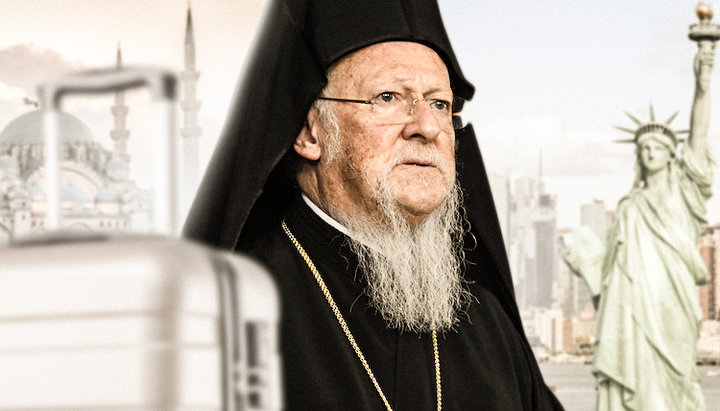Will the Phanar head move from Istanbul to the USA?

The Synod of the Patriarchate of Constantinople has announced the creation of a new Charter of the Archdiocese of America. Why does the Phanar need a new one?
On October 6, 2020, the Phanar Synod decided to suspend the Charter of the Greek Orthodox Archdiocese of America and announced the creation of a new Charter.
Commenting on this synodal resolution, the head of the Archdiocese of America, Archbishop Elpidophoros, said: “ Today we feel blessed because with this decision, the Ecumenical Patriarchate gives us the great opportunity to envision and design our Church together in view of its 100th anniversary.” He assured that a joint committee will be created for the new Charter, which will include representatives of the clergy and laity of the Archdiocese and representatives of the Phanar. Moreover, Elpidophoros thanked the “leader of Orthodoxy”, Patriarch Bartholomew, for “a wonderful opportunity to rebuild our Archdiocese from the ground up ”.
Agree that in the light of the almost century-long existence of the Phanar’s Archdiocese in the United States, these statements look very strange. After all, Elpidophorus did not come to an empty place. What, then, do the words about “rebuilding from the ground up” mean – destroying the old structure to the ground or reformatting it for new realities? Or, as the United States rightly asks, for the current head of the Archdiocese? To answer these questions, we must return to the events that led Elpidophoros to the post of the head of the Greek Orthodox Archdiocese of America.
History of the "election" of Elpidophoros
In the early 2000s, when Archbishop Demetrios became the head of the Greek Orthodox Archdiocese of America, Patriarch Bartholomew attempted to surbodinate the administration of this structure to himself by appointing “his” person there. Therefore, from the year 2008 onwards, Patriarch Bartholomew tried to convince Archbishop Demetrios to resign, which he invariably refused. Only in 2019, after another personal meeting with the head of the Phanar, the 91-year-old hierarch announced his retirement. On May 11, the press service of the Patriarchate of Constantinople reported that at the Synod held Archbishop Elpidophoros (born Ioannis Lambriniadis) was elected (and actually appointed – Ed.) of the three candidates for the post of head of the Archdiocese of America. In mid-June, after his enthronement in New York, Archbishop Elpidophoros headed the Phanariot structure in the United States.
A Turkish citizen and native of Istanbul, Lambriniadis had already lived in the United States for quite some time. It was he who in 2009 spoke at the Brooklyn Orthodox Theological School of the Holy Cross with a call to streamline the canonical order of the Orthodox Church on the American continents and to unite under the omophorion of Constantinople. Also, Lambriniadis penned the development of the concept "the first without equal", according to which the Patriarch of Constantinople is the leader of world Orthodoxy.
At the same time, taking into account the process of “election”, the appearance of Archbishop Elpidophoros at the American See almost from the very beginning was associated with a series of scandals and discontent. First, among the three candidates for the throne, there was not a single representative of the American Archdiocese.
The appearance of Archbishop Elpidophoros at the American See almost from the very beginning was associated with a series of scandals and discontent.
Secondly, the "elections" themselves were held in a great hurry. Judge for yourself: on May 4, Archbishop Demetrios resigned. On May 9, the Holy Synod of the Ecumenical Patriarchate accepted his resignation. On May 10, the Phanar press service (following a request from the Council of the Archdiocese) assured that the elections for the post of head of the American structure would take place no earlier than mid-June, and already on May 11 (the next day!) it became known that the Phanariots voted for the appointment of Elpidophoros.
Thirdly, it was quite reasonably believed in America that the canonical procedure was violated during the elections. Thus, the source of the RIA Novosti publishing house said that according to the canons, “the diocesan Synod must be held to propose its candidates, and the list of the patriarchate must include at least one of them. But among the three candidates, there was not one of the American metropolitans. This is a great challenge for metropolitans — there are eight of them in America." In addition, the Phanar ignored the Charter of the Archdiocese of America, according to which “the opinion of local synods and meetings of clergy and laity should be taken into account. This works at all levels: priests, metropolitans cannot do what they want."
It should be emphasized here that the Greek Orthodox Archdiocese of America is not only the largest unit in the Constantinople Patriarchate but also the most freedom-loving. It is so much freedom-loving that one of America's richest Greeks, Efstathios Valiotis, advocated for its autocephaly in 2018. And there is no doubt that he expressed not only his own opinion.
In a word, the story of the "elections" of Elpidophoros in the USA made it finally clear that the Phanar is determined to change the situation in the Archdiocese. To implement these plans, it is necessary to take specific steps, among which, according to the Phanar, is a “clean-up” of all the disgruntled. In this context, a ban of the Boston metropolitan and the removal of the New Jersey metropolitans, which we wrote about, look quite logical – to show all other hierarchs that the Phanar intends to act decisively and mercilessly. Drafting the Charter is the next step.
What is wrong with the “old” Charter and why is the “new” one needed?
According to the current structure of the Archdiocese, the Greek Church in the United States consists of an archbishopric district (which includes the parishes of New York) and eight metropolises (Boston, Pittsburgh, New Jersey, Atlanta, Detroit, Chicago, Denver and San Francisco).
The head of the Archdiocese has no real powers or jurisdictional rights in the affairs of each metropolitanate. Such a structure appeared in 1997 as a response of the Patriarchate of Constantinople to the attempt by the then Archbishop James to unite the Orthodox Churches of all jurisdictions into one American Church.
At that time, in an effort to maintain control over the Churches in the Western Hemisphere, Patriarch Bartholomew split the Church into separate entities, creating metropolises in Buenos Aires, Central America, Mexico, USA and Canada.
In an effort to maintain control over the Churches in the Western Hemisphere, Patriarch Bartholomew split the Church into separate entities, creating metropolises in Buenos Aires, Central America, Mexico, USA and Canada. It was a classic example of the “divide-and-rule” principle.
In the case of the United States, Bartholomew divided the country into eight metropolises, each of which was directly subordinate to him, and one “archbishop's district”, which was under the jurisdiction of the Archdiocese.
It was a classic example of “divide-and-rule” principle and a clear attempt to split a powerful and unified entity (then ruled by Archbishop Jacob) in order to maintain control of the entire Western Hemisphere. Having created smaller formations that were directly subordinate to the Patriarchate of Constantinople, the head of the Phanar weakened the powers of the head of the Archdiocese as much as possible.
The process is reversed now. Having made the decision to abolish the old Charter, the Phanar obviously intends to amend it, according to which the independent metropolises of the Archdiocese of America will be under the direct jurisdiction and control of the head of the Archdiocese. It is quite possible that the existing metropolises, which have a certain status in the Greek tradition, will be reduced to the status of dioceses. In this case, all heads of dioceses will report directly to New York.
An indirect confirmation of just such a scenario can be seen in the words of Elpidophoros, who, commenting on the abolition of the Charter, stated: "We have just received a wonderful opportunity to rebuild our Archdiocese from the ground up ...."
In other words, the decision to draft the Charter of the American Archdiocese of the Phanar was dictated by the desire to return it to a clear centralized government, which would deprive the metropolises of their freedom. The new Charter will protect the head of the Archdiocese from all kinds of "underwater" currents and problems – for example, the unification of all American jurisdictions into one with the withdrawal from the Phanar's subordination, or disgruntled rebels, as in the case of Boston and New Jersey.
Another question is: why would Bartholomew do this? After all, the situation may sooner or later get out of control and return to the situation that was under Archbishop Jacob - with the desire for autocephaly and separation from Constantinople. Isn't that a risk? To some extent, it is. Unless you know that the Phanariotes are planning their actions for many years ahead (Elpidophoros speaks about 100 years) and are already thinking about what awaits the Archdiocese and the Patriarchate in the future. And here is the most interesting thing.
A "new" Charter for a new head?
Based on the recent actions of the Turkish government to transform the two most significant objects of Orthodox spiritual heritage into mosques – the Hagia Sophia Church and the Chora Monastery in Istanbul – it can be concluded that there will be no quiet life for Phanariots in Turkey. At the moment, relations between Istanbul and the Phanar are already strained, and if we recall the situation with the attempted coup d'état and accusations against Patriarch Bartholomew of ties with the instigator of this coup, Fatih Güllen, it is obvious that sooner or later the Turkish authorities will raise the question of the very existence of the Patriarchate of Constantinople on their territory. Add to this the conflict between Turkey and Greece and Cyprus, and it becomes clear that the possible removal of the “Hellenic” patriarch from Istanbul is only a matter of time.
At the same time, Patriarch Bartholomew is already 80 years old and it has long been said that Archbishop Elpidophoros will become the next patriarch. The question is if he will be able to fulfil his functions in Istanbul? Hardly. And for the reasons mentioned above, and because he is most likely an ethnic Kurd. And to say that a Kurd will settle in Phanar, in the very heart of Islamic Turkey, is possible only in very daring fantasies.
Therefore, it can be assumed that the epic with the revision of the Charter is the first step towards transferring the See of the Patriarchs of Constantinople from Istanbul to the United States. For this, it is necessary to subordinate all the American metropolises to a single New York-based center. If Elpidophoros becomes the Patriarch of Constantinople, then the decision to draft the Charter is quite logical – he changes it for himself.
The decision to draft the Charter of the Greek Orthodox Archdiocese of America was dictated by the desire to return it to a clear centralized government, which would deprive the metropolises of their current freedom.
On the other hand, if the See of the Phanariots remains in Istanbul and someone else becomes the Patriarch, not Elpidophoros (which is unlikely), then in this case, the new Charter is beneficial to the current head of the Archdiocese since it gives him real strong power.
At the same time, even the synodal suspension of the old Charter means that in America everything now is decided by one person – Elpidophoros. Indeed, having suspended the Charter of the Archdiocese, the Synod clearly showed that the entire American structure can function normally without the current Charter and be governed by one hierarch.
The fact that the Charter is being revised exclusively for Elpidophoros is loudly said in the United States. Moreover, the American Greeks tend to think that this is not only a desire to run the Archdiocese administratively but also financially. And what is most interesting is to put all the clergy in direct dependence on the decisions of the central government in New York.
Sources within the Archdiocese report that Elpidophoros sent a letter a few days ago to Fr. James T. Paris, Chairman of the Archdiocesan Benefits Committee, stating that the head of the Archdiocese wants to personally appoint at least three members of his choice to the administrative subcommittee of the Archdiocesan Benefits Committee. This is necessary in order to take control of all benefits (including pension benefits) that are paid to priests. However, this organization is independent and has its own Charter, which Archbishop Elpidophoros was reminded of.
This fact, in addition to the future drafting of the Charter, led to the fact that, according to available information, at least ten parishes have already withheld their monthly payments to New York. A letter from a parish priest, addressing his parishioners about everything that is happening, appeared in the Greek-American media. According to him, "a Parish Priest traditionally refrains from offering any support about any decision that would involve going against the Archdiocese". However, he writes, “I would argue that since Archbishop Elpidophoros has suspended the Charter, the Regulations that were in place no longer apply since there is currently no Archdiocese. Archbishop Elpidophoros has no canonical authority over this parish or to me as a priest. As the spiritual father of this community, I believe it is in our best interest to immediately begin discussing the possibility of withholding our monthly payments to New York until a time when there is no ambiguity about the new vision that is being created in New York. ”
And further: “I would also like to express my thoughts that the parish council does not need to worry about any consequences (i.e. losing their priest) by moving forward with this decision. Our Metropolitan is more focused about losing his own job at the present moment than being attentive which parishes are paying their dues and which ones are not. With God’s protection, we will be just fine."
Particularly striking in this situation is the contrast between the statements by the Phanar regarding the defense of the "democratic rights" of the Churches in foreign canonical territory and the outright tyranny in their own structures. This is most clearly seen in the thesis "every state has the right to its own autocephalous Church". Of all states, the United States definitely has the right to its own autocephalous Church, as do Finland, Australia and other countries.
***
What is the bottom line? It is quite obvious that the Greek Orthodox Archdiocese of America is going through a new crisis. And, as before, this crisis arose due to the tough and imperious actions of the Patriarchate of Constantinople. Of course, this does not mean that the structure of the Phanar in the United States will collapse and cease to exist – the ties within the Greek communities are too strong. However, the fact that fermentation may lead to a split in the Archdiocese cannot be ruled out either. For example, several parishes have already announced their intention to transfer to the jurisdiction of the Antioch Patriarchate.
Particularly striking in this situation is the contrast between the statements by the Phanar regarding the defense of the "democratic rights" of the Churches in the foreign canonical territory and the outright tyranny in their own structures. This is most clearly seen in the thesis "every state has the right to its own autocephalous Church". Of all states, the United States definitely has the right to its own autocephalous Church, as do Finland, Australia and other countries.
Obviously, at the moment, Archbishop Elpidophoros, through the Phanar, is attempting to get his hands on America. And in this sense, it does not matter whether he is doing this because of his personal ambitions or just following Patriarch Bartholomew’s instructions. What matters is whether the historic coup d'état is being prepared in connection with the relocation of the See of the Patriarchate of Constantinople from Istanbul to New York or whether the Phanar's desire to fully control its jurisdictional boundaries is behind all this? We will learn about this soon.











